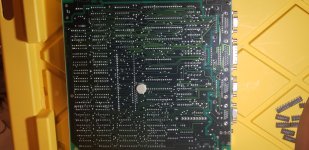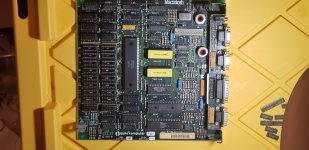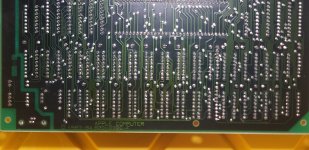Eudimorphodon
Veteran Member
Horizontally, it looks like it repeats every +1 and +8 and/or -7 and -8 words. Vertically, it looks like +7 and +8... I'd start with the 8, which would relate to A3 or RA3F from the schematic. It looks like RA3 is generated by IC 2F, a 74LS257, or the 74AS253 at 3F (depending on the state of the DMA signal) and becomes RA3F after passing through a 47 ohm resistor in RP2...
I looked up the one schematic for these machines that's reasonably easy to find and... ugh. Just ugh. Maybe there's no more efficient way to do what they needed to do but that mix of 1-of-2 and 1-of-4 multiplexers to switch between the CPU, video, and audio buffer addresses is kind of a nightmare...
That said, from looking at this and comparing the mod instructions to the memory maps for the 128k and 512k macintoshes the theory behind the actual mod should be pretty simple, right? Essentially all it should be doing is taking an NC line to the memory sockets, connecting it to *one* of the outputs on the added 'AS253, and multiplexing that line between either CPU A17/A18 (if the CPU is selected) or just outputting a "1" if video or sound is selected, right? (The memory map I found suggested that the video and sound buffers are always located at the highest point in memory on all the original toasters, so outputting a "1" on these lines when "DMA" is selected should kick them up to the very top of memory, right?) If that's all it's doing then it's genuinely difficult to see how the damage that's clearly been inflicted to cause this corruption could have come simply from the installation of the mod components themselves.
Are there pictures of the current state of this board posted anywhere?





